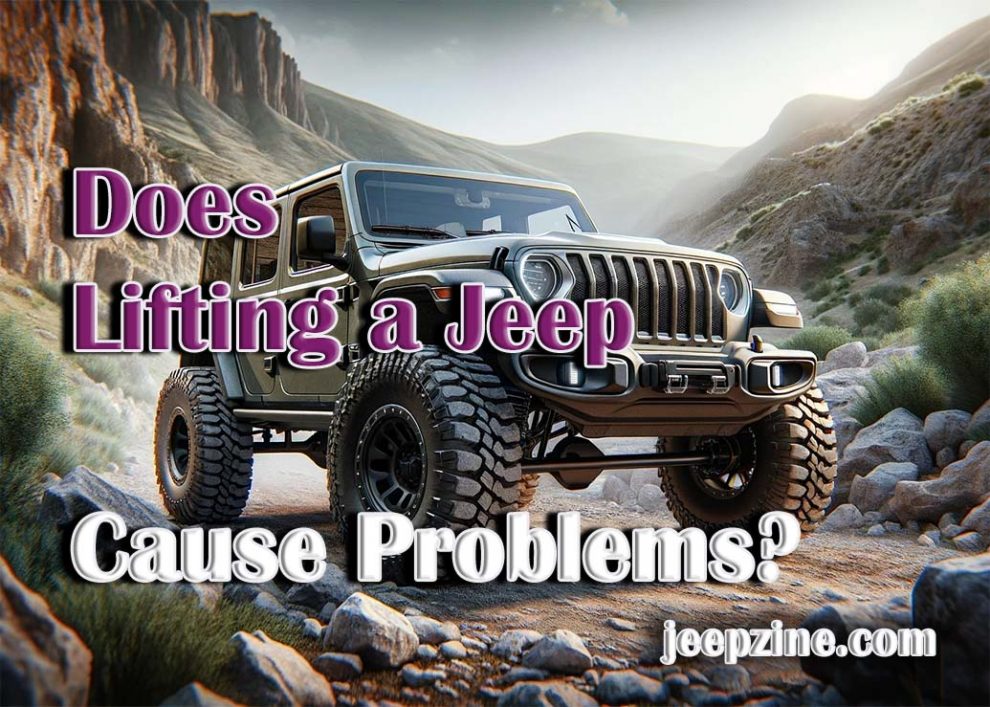Lifting a Jeep Wrangler or Gladiator adds greater ground clearance for off-roading and gives these iconic 4x4s an aggressive, rugged look. However, significantly raising ride height also places more stress on factory components and alters key suspension geometry, drivetrain angles, and weight distribution. If the lift height and parts are not carefully matched to the Jeep model, major issues can occur. This comprehensive article will analyze common problems that can arise after improperly lifting your Jeep. We will explore impacts to steering and suspension, drivetrain vibrations, tire wear, fuel mileage, safety margins, and increased forces on critical components. Wise Jeep owners considering a lift should understand these tradeoffs and upgrade accordingly to maximize off-road potential while preserving reliability.
Impacts on Suspension and Steering
One of the most pronounced effects of lifting any 4×4 is the change to suspension angles and steering geometry. Essentially, the entire front and rear suspension is being raised from its original design height. This alters the angle of control arms, track bars, sway bars, struts or coils springs as well as steering linkages. A quality lift kit attempts to compensate for these changes but often some factory alignment specifications cannot be fully retained. The result is increased bump steer, wander, looseness, and poor tire wear. Upgraded steering stabilizers and shocks help mask alignment issues but do not eliminate them. Proper professional installation and alignment is critical to minimize degradation of your Jeep’s steering and suspension after lifting.
Drivetrain Alignment and Vibration Issues
Raising a Jeep’s body elevation also impacts the original drivetrain angles, especially the critical propeller shaft and pinion angles. Running prop shafts and pinions outside factory specifications causes driveline vibration, binding, accelerated wear, noise, and power loss. Preserving correct drivetrain geometry is crucial. High-end lift kits include adjustable rear control arms, cam bolts, shims, and skids to realign components within acceptable angle ranges after lifting. Nonetheless, some vibration and subsequent wear is almost unavoidable. Be prepared to service worn U-joints, slip yokes, and pinion bearings more frequently post-lift.
Increased Tire Wear and Wheel Stress
The larger, heavier all-terrain tires typically installed on lifted Jeeps place more load on factory wheels, hubs, bearings, differentials, axles, and steering components. The increased leverage from big tires also amplifies any suspension geometry flaws. Rapid tread wear along the outer tire shoulder as well as cracked wheels are common issues directly linked to the stress of oversized tires after lifting. Quality lift components engineered for specific tire sizes will help minimize wear and damage but cannot prevent it entirely. Budget for replacement wheels and tires more often with a lifted Jeep.
Loss in Fuel Efficiency
Multiple factors contribute to reduced fuel mileage after significantly increasing ride height. The less aerodynamic shape, increased weight, greater rolling resistance, and larger tire friction surface all hurt efficiency—as much as 15-25% by some estimates. Furthermore, skid plates, bars, and tread patterns optimized for off-road traction rather than on-road efficiency exacerbate mileage losses. If gas costs are a concern, keep this mileage penalty in mind when planning a lift for your Jeep.
Compromised Stability and Safety Factors
Jeeps inherently have a higher center of gravity that lifting exaggerates. The taller you go, the more prone the vehicle becomes to rollover or tipping during tight turns, evasive maneuvers, and off-camber hill climbs. Braking and handling are also compromised, forcing stability control systems to work harder. An extreme lift negatively impacts key safety metrics. Prioritize sensible lift heights and quality components that enhance off-road capability without pushing stability boundaries.
Additional Forces on Critical Components
Carefully consider the heightened stresses a lift places on:
- Ball joints, control arms, bushings
- Shock absorbers, steering stabilizers
- Brakes dealing with increased mass
- Wheel bearings supporting more load
- Differentials, axle shafts handling greater torque
Engineers try to account for these forces when designing lift components, but factory parts often wear quicker regardless. Inspect your brakes, steering, drivetrain, and hardware frequently post-lift. Be prepared to replace components earlier to maintain reliability.
Conclusion
Does installing a lift kit on your Jeep introduce potential problems? With careful component selection, professional installation, and routine maintenance, major issues can be avoided or minimized. But realistically, lifting any 4×4 does involve some unavoidable compromises in ride quality, drivability, stability, efficiency, and component longevity compared to a stock, unmodified suspension. As a wise Jeep owner, thoroughly research the impacts of lifting before committing to significantly increasing ride height. Weigh the benefits of greater off-road clearance and aggressive aesthetics against the tradeoffs covered in this article. For all lift considerations on the compact Jeep Renegade, be sure to check out our detailed guide covering Jeep Renegade lift kits. While a lifted Jeep requires extra diligence to maintain reliable performance, the boost in capability and curb appeal is often worth the effort for hardcore off-road enthusiasts. With eyes wide open to both benefits and consequences, your lifted Jeep can conquer trails while turning heads on the streets.


